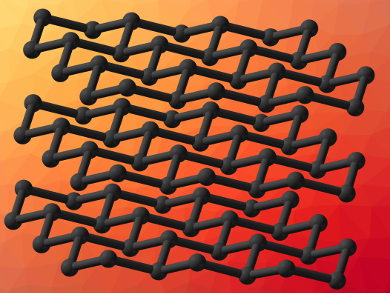Phosphorene (pictured) is a semiconducting 2D material, composed of black-phosphorus-like single layers. Quantum dots are very small particles of semiconductor materials. Phosphorene quantum dots show electrocatalytic activity for oxygen evolution reactions (OERs), a type of reaction that splits water to form molecular oxygen.
Manikoth M. Shaijumon, Indian Institute of Science Education and Research Thiruvananthapuram, and colleagues have synthesized phosphorene quantum dots, using a two-electrode electrochemical exfoliation process with black phosphorus crystals as the precursor material. A 3 V potential was applied to a black phosphorus crystal anode in an electrolyte solution consisting of LiClO4 in formamide against a platinum counter electrode. The resulting quantum dots were surface-functionalized with nitrogen-containing groups during the process.
The quantum dots were characterized and their electrochemical properties were determined using, among other methods, linear sweep voltammetry, cyclic voltammetry, electrochemical impedance spectroscopy (EIS), UV-vis and near-infrared (NIR) spectroscopy, X-ray photoelectron spectroscopy (XPS), transmission electron microscopy (TEM), and atomic force microscopy (AFM).
The functionalized phosphorene quantum dots have a high efficiency and stability for OER reactions, with an overpotential of 1.66 V at 10 mA cm–2, a low Tafel slope of 48 mV dec–1, a low electrical resistance of 295 Ω and stability for over 10 hours. The results show promise for phosphorene quantum dots as an anode material in alkaline water splitting applications.
- Functionalized Phosphorene Quantum Dots as Efficient Electrocatalyst for Oxygen Evolution Reaction,
Ranjith Prasannachandran, Thazhe Veettil Vineesh, Athira Anil, B. Murali Krishna, Manikoth M. Shaijumon,
ACS Nano 2018.
https://doi.org/10.1021/acsnano.8b06671




